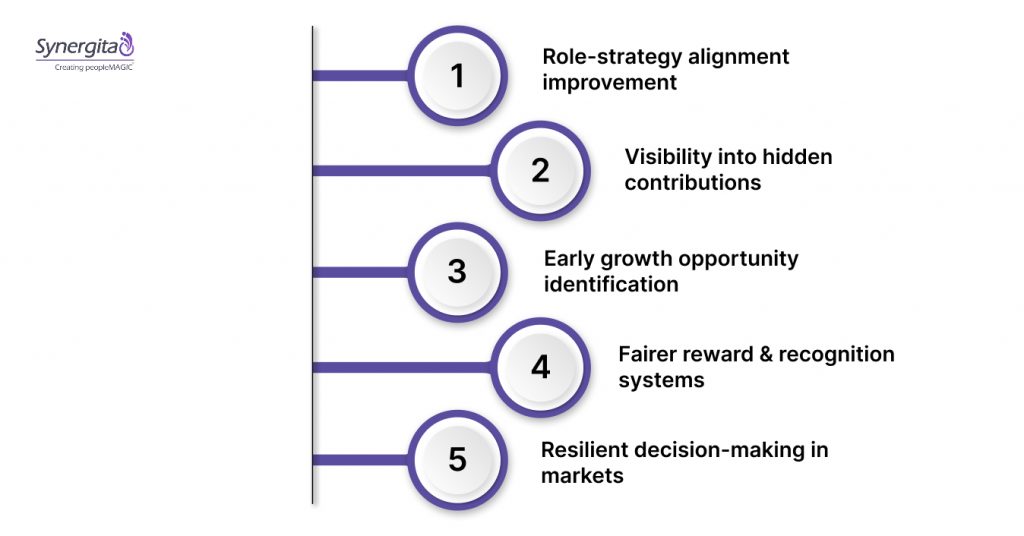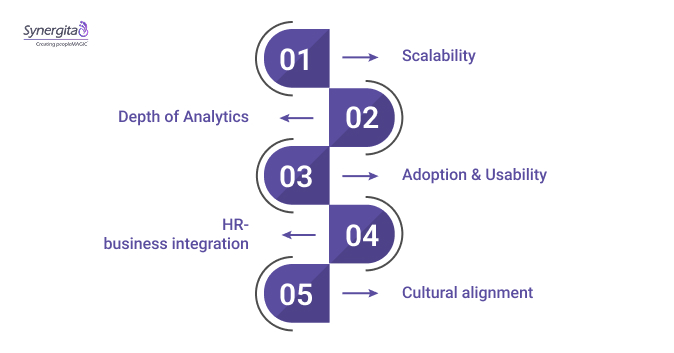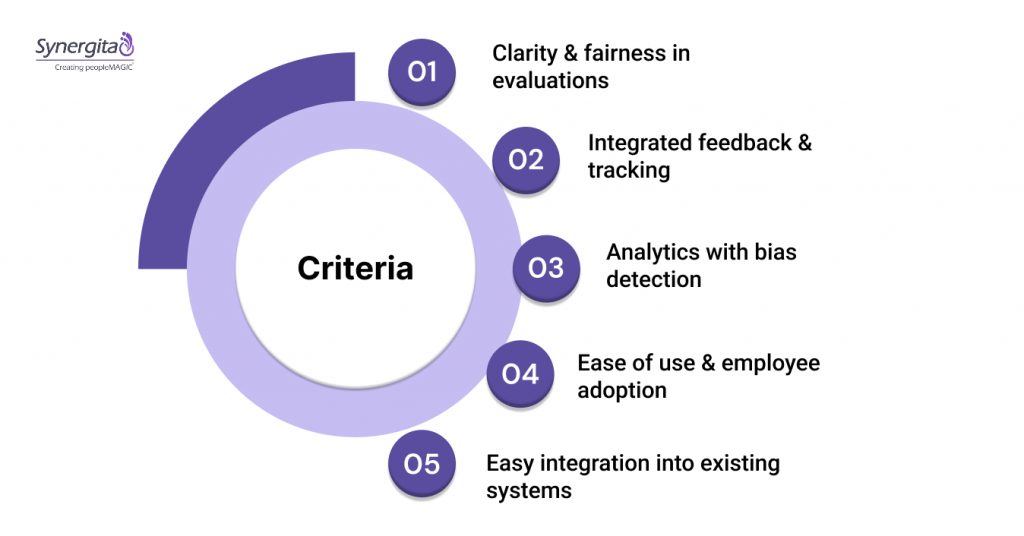The way we measure employee performance is undergoing a major shift. Have you ever looked at a performance review and thought, “This doesn’t really show the value this person brings”? You are not alone. For years, organizations leaned on output-only metrics like hours logged, tasks completed, or quarterly targets hit. But in 2025, those numbers alone no longer tell the full story. What matters most is the actual value employees create and how their contributions move the business forward in measurable ways.
Modern performance management is no longer about gut instinct or vague notes at the end of the year. Analytics gives leaders a clear view of how each person’s work connects to business outcomes. With the right insights, managers can recognize real impact, reduce bias, and make evaluations more fair and consistent.
To help HR leaders navigate this shift, here are the key trends and insights shaping value-based performance management in 2025.
Key Takeaways
- The Shift to Value: Focus on outcomes, not tasks. HRs can implement this by linking KPIs to measurable business results.
- Analytics at the Core: Use dashboards to identify high-impact contributors and hidden gaps.
- Features That Matter: Prioritize tools that integrate analytics, feedback, and goal tracking seamlessly.
- Top Tools for 2025: Leading platforms include Synergita, Workday, Lattice, Culture Amp, Betterworks, 15Five, and BambooHR.
- Future of Reviews: AI-driven insights can detect rating inconsistencies, highlight bias patterns, and predict employees’ growth potential. HRs can use these predictions to target development plans, anticipate high-performers, and make fairer promotion decisions.
Before we dive into specific tools, it’s important to understand what value-based performance management analytics really means and why it matters.
What is Value-Based Performance Management Analytics
Value-based performance management analytics measures employees by the business impact they create, not by how many hours they work or tasks they check off. It looks at whether their contributions actually move the organization closer to its goals.
Unlike traditional reviews that stop at activity metrics, this approach connects effort to measurable outcomes. For example, instead of praising a sales executive for making 200 calls in a quarter, analytics shows whether those calls translated into higher revenue or stronger client retention.
What makes this approach powerful is analytics. It turns what might feel subjective into data driven insights leaders can act on. With clear visibility into outcomes, managers can:
- Evaluate fairly by comparing results against agreed goals rather than impressions.
- Recognize true value even when contributions are less visible, such as process improvements or collaboration wins.
- Make informed decisions on promotions, compensation, and development based on evidence, not assumptions.
By focusing on impact instead of output, value-based performance management analytics helps organizations see who is making a real difference and where coaching or support is needed.
The next question is quite obvious. You might wonder why organizations are investing in these tools, and what benefits they can expect. Here’s what you need to know.
Why Companies Need Value-Based Performance Management Tools

Value-based performance management tools go beyond tracking outcomes; they change how organizations understand, support, and grow their people. The real advantages emerge when data-driven insights are applied consistently across teams.
- Stronger alignment between roles and strategy: These tools connect day-to-day contributions to company priorities, showing employees how their work advances strategic objectives. That line of sight builds accountability and helps people prioritize efforts that matter most.
- Visibility into hidden contributions: Not all impact shows up in sales numbers or project deadlines. Analytics highlights less visible but critical work, such as knowledge sharing, mentoring, or improving internal processes that save time and money.
- Early identification of growth opportunities: By spotting patterns in performance data, leaders can recognize potential before it shows up in traditional metrics. This enables targeted development plans that prepare employees for bigger responsibilities sooner.
- Fairer reward and recognition systems: When impact is measured consistently across teams, recognition is no longer limited to those in high-visibility roles. Employees in supportive or cross-functional positions also get credit for their contributions.
- Resilient decision-making in dynamic markets: Because these tools provide real-time insights, managers can adjust expectations quickly when business priorities shift. This agility ensures performance reviews stay relevant, even in fast-changing environments.Recognizing the benefits of value-based performance management reveals that the right software can significantly impact outcomes. Let’s explore the top tools that are helping companies bring this approach to life in 2025.
Best Value-Based Performance Management Analytics Software of 2025
Finding the right performance management software is about more than features. It is about choosing a tool that fits your culture, aligns with your goals, and provides the analytics you need to make decisions without bias. Here are the top tools in 2025 that stand out for value-based performance management.
1. Synergita

Synergita focuses on building fair and bias-free performance reviews with real-time analytics. It ensures that every contribution is visible and evaluated consistently.
Best for: Companies that want transparent, unbiased, and continuous evaluations.
Features:
- Goal cascading and alignment
- Continuous feedback and recognition
- Analytics dashboards with bias detection
Pros: Easy to use, strong bias detection, affordable for SMEs
Cons: May lack enterprise-scale integrations
2. Workday
Workday is an enterprise-grade HR and performance system that blends analytics with HRIS, payroll, and finance. It’s a comprehensive solution for organizations managing complex workforce structures.
Best for: Large organizations with integrated HR and finance needs.
Features:
- Deep analytics across workforce lifecycle
- Strong HR and finance integration
- Predictive insights for succession planning
Pros: Robust analytics, excellent scalability, enterprise integrations
Cons: Expensive, long implementation time
3. Lattice
Lattice combines performance reviews, goal-setting, and engagement into one unified platform. It’s designed to help mid-sized businesses scale performance and culture together.
Best for: Mid-sized companies growing fast and seeking a unified tool.
Features:
- OKRs and performance tracking
- Engagement and survey tools
- Career development and growth paths
Pros: Strong focus on engagement + performance, clean interface
Cons: Pricing may be steep for smaller businesses
4. Betterworks
Betterworks is an OKR-driven platform that keeps performance tightly linked to measurable results. It’s ideal for outcome-focused organizations that want to monitor progress in real time.
Best for: Companies that prioritize OKR alignment and measurable outcomes.
Features:
- Real-time OKR tracking
- Progress dashboards
- Goal slippage alerts and reporting
Pros: Excellent for OKR adoption, real-time insights
Cons: Not as strong on engagement or culture features
5. Culture Amp
Culture Amp bridges performance management with engagement and DEI analytics. It helps leaders connect performance with culture to ensure growth is fair and inclusive.
Best for: Organizations focusing on culture, inclusion, and feedback analytics.
Features:
- Engagement and culture analytics
- Feedback-driven reviews
- DEI dashboards and reporting
Pros: Strong culture and inclusion focus, excellent survey analytics
Cons: Limited advanced performance tracking compared to competitors
6. 15Five
15Five emphasizes continuous performance improvement with a focus on employee wellbeing and manager effectiveness. Its analytics surface both performance and engagement drivers.
Best for: Companies wanting a balance of performance and people development.
Features:
- Weekly check-ins and pulse surveys
- Performance reviews and 1-on-1s
- Engagement and wellbeing analytics
Pros: Strong people-first approach, easy manager adoption
Cons: Less advanced for large enterprise analytics
7. BambooHR
BambooHR combines lightweight HR management with performance tracking. While simpler than enterprise tools, it provides growing organizations with accessible value-based insights.
Best for: Small to mid-sized businesses needing HR + performance in one.
Features:
- Performance reviews and self-assessments
- Goal tracking and feedback tools
- Core HR functions (payroll, benefits, ATS)
Pros: Affordable, all-in-one HR + performance, great for SMBs
Cons: Limited advanced analytics, not built for very large teams
Each of these platforms has its strengths and focus areas. To make it easier to compare them at a glance, here’s a quick summary of features, pricing, and ideal users.”
Quick Comparison of Top Tools in 2025
| Software | Quick Summary | Price Estimate | Best For |
| Synergita | Bias-free reviews with continuous feedback and analytics | $2–7 per user/month | SMEs needing fair and transparent reviews |
| Workday | Enterprise HR + performance + finance in one system | $40–60 per user/month | Large enterprises with complex HR needs |
| Lattice | Combines OKRs, performance, and engagement in one tool | $11 per user/month, $4K min yearly | Mid-sized, fast-scaling companies |
| Betterworks | OKR-first performance platform with real-time tracking | Contact vendor | Companies prioritizing measurable outcomes |
| Culture Amp | Links performance with culture, inclusion, and engagement | Contact vendor | Organizations focused on culture and DEI |
| 15Five | People-first platform combining performance, engagement, and wellbeing | $9 per user/month | Companies balancing performance and people development |
| BambooHR | All-in-one HR suite with performance and goal tracking | $6–8 per user/month | Small to mid-sized businesses needing HR + performance |
While the table helps you see differences quickly, choosing the right tool goes beyond features. Here’s how HR leaders can evaluate which platform fits their organization best.
How to Choose the Right Performance Management Analytics Tool

Selecting the right tool is not just about ticking off a feature list. It is about finding a system that matches your company’s size, culture, and growth plans. HR leaders should start by asking:
- Does the tool measure performance in a way that reflects our business goals?
- Can it adapt as we scale to new markets, products, or teams?
- Will employees and managers actually use it, or will it become another system people avoid?
A simple evaluation checklist can make the difference:
- Scalability: A tool that works for a 200-person company may not hold up when you expand to 2,000. Beyond just user capacity, scalability means the system can handle more complex org structures, multiple geographies, and varying compliance needs without slowing down. For example, a startup moving into global markets needs software that can adapt to new currencies, languages, and reporting hierarchies while still delivering consistent analytics.
- Depth of Analytics: The strongest platforms don’t stop at dashboards. They uncover hidden insights, like rating inconsistencies between managers or patterns where certain departments receive less recognition. For instance, analytics should be able to reveal if engineering contributions are undervalued compared to sales achievements, giving HR leaders the data they need to correct systemic gaps.
- Adoption and Usability: If employees and managers avoid the system, even the smartest tool fails. Adoption is driven by design that fits seamlessly into daily workflows, not just HR checklists. Look for features like mobile-first access for frontline staff, integrations with collaboration tools like Slack or Teams, and interfaces that guide managers through giving actionable, evidence-based feedback rather than leaving them with blank text boxes.
- Integration with HR and Business Systems: Performance analytics cannot live in isolation. The best platforms connect with HRIS, payroll, and business intelligence systems so leaders can link performance to compensation, promotions, and business outcomes without juggling spreadsheets. A good example is tying sales performance data directly to client retention or revenue growth metrics, making reviews directly relevant to financial health.
- Alignment with Company Culture: The right tool should reinforce how your organization defines success. A product-led company might value innovation and cross-team collaboration, so its platform should highlight contributions beyond individual output. A fast-scaling sales organization, on the other hand, may prioritize measurable OKRs and deal-closing velocity. A mismatch here creates friction: employees end up chasing metrics that do not reflect what leadership truly values.
To give more clarity on what really matters, here’s a closer look at the criteria we used to rank the best performance management software for 2025
Criteria for Ranking the Best Software in 2025

Not all performance management tools are built the same. To separate real impact from empty promises, we looked at the features that actually make a difference for leaders and employees in 2025.
- Clarity and fairness in evaluations: The best platforms show exactly how ratings are determined and give employees confidence that reviews are based on facts, not favoritism.
- Built-in feedback and goal tracking: Effective tools capture progress continuously rather than waiting until the end of the year. This ensures small wins and course corrections are never lost.
- Advanced analytics with bias detection: Top-ranked platforms go beyond reporting. They surface rating patterns, spot inconsistencies across teams, and highlight areas where bias may be influencing outcomes.
- Ease of use and employee adoption: Even the smartest software fails if people don’t use it. Our picks balance powerful analytics with a simple, intuitive design that managers and employees actually engage with.
- Easy integration into existing systems: The strongest solutions connect easily with HR, payroll, and business platforms, so organizations get a unified view of performance and impact without duplicate effort.
Understanding these criteria equips HR leaders to make informed decisions. With the right tool, organizations can measure true impact, reduce bias, and create a culture where performance and recognition go hand in hand.
Conclusion
The future of performance management is not about more dashboards or longer review forms. It is about ensuring that every evaluation reflects real impact and gives employees confidence that their work is seen and valued. Companies that fail to move beyond task counting risk losing their best people to organizations that measure and reward outcomes fairly.
That is where platforms like Synergita make the difference. By combining continuous feedback, cascading goals, and bias-aware analytics, Synergita helps leaders replace subjectivity with clarity and build a culture where trust and performance reinforce each other.
If you are ready to see how fair, data-driven reviews can transform both engagement and results in your organization, try it yourself.
Start your free trial of Synergita today and experience value-based performance management in action.
FAQs
Q: Which performance management tools support cascading goals?
A: On Reddit’s HR forums, BambooHR is often mentioned for its goal alignment features. It helps cascade objectives from leadership down to teams, making strategy execution more transparent.
Q: What are the best HR tools for employee performance assessment?
A: Quora discussions point to platforms like Lattice, Synergita, and Workday. These tools not only track performance but also connect assessments to development opportunities and business impact.
Q: Which software helps with people analytics?
A: Reddit and Quora threads highlight Leapsome, Culture Amp, and 15Five. These platforms combine performance tracking with engagement insights, giving HR leaders a full view of workforce health.
Q: Are there AI tools that improve performance analytics?
A: Yes, several discussions highlight AI-driven platforms that detect hidden trends. Tools like Evalio, DataRobot, and Domo automate pattern recognition, making it easier to spot bias or growth opportunities.
Q: What are good alternatives to traditional performance reviews?
A: Many HR leaders are moving away from annual reviews toward continuous feedback, OKR-driven platforms, and 360-degree evaluations. Tools like Synergita, Lattice, and 15Five make this shift easier by combining structured reviews with real-time input.

